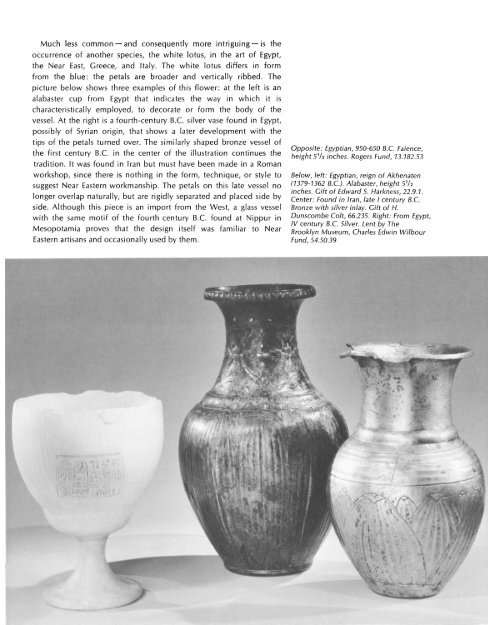The Metropolitan Museum of Art Bulletin, v. 29, no. 7 (March, 1971)
The Metropolitan Museum of Art Bulletin, v. 29, no. 7 (March, 1971)
The Metropolitan Museum of Art Bulletin, v. 29, no. 7 (March, 1971)
You also want an ePaper? Increase the reach of your titles
YUMPU automatically turns print PDFs into web optimized ePapers that Google loves.
Much less common - and consequently more intriguing- is the<br />
occurrence <strong>of</strong> a<strong>no</strong>ther species, the white lotus, in the art <strong>of</strong> Egypt,<br />
the Near East, Greece, and Italy. <strong>The</strong> white lotus differs in form<br />
from the blue: the petals are broader and vertically ribbed. <strong>The</strong><br />
picture below shows three examples <strong>of</strong> this flower: at the left is an<br />
alabaster cup from Egypt that indicates the way in which it is<br />
characteristically employed, to decorate or form the body <strong>of</strong> the<br />
vessel. At the right is a fourth-century B.C. silver vase found in Egypt,<br />
possibly <strong>of</strong> Syrian origin, that shows a later development with the<br />
tips <strong>of</strong> the petals turned over. <strong>The</strong> similarly shaped bronze vessel <strong>of</strong><br />
the first century B.C. in the center <strong>of</strong> the illustration continues the<br />
tradition. It was found in Iran but must have been made in a Roman<br />
workshop, since there is <strong>no</strong>thing in the form, technique, or style to<br />
suggest Near Eastern workmanship. <strong>The</strong> petals on this late vessel <strong>no</strong><br />
longer overlap naturally, but are rigidly separated and placed side by<br />
side. Although this piece is an import from the West, a glass vessel<br />
with the same motif <strong>of</strong> the fourth century B.C. found at Nippur in<br />
Mesopotamia proves that the design itself was familiar to Near<br />
Eastern artisans and occasionally used by them.<br />
Opposite: Egyptian, 950-650 B.C. Faience,<br />
height 5'/2 inches. Rogers Fund, 13.182.53<br />
Below, left: Egyptian, reign <strong>of</strong> Akhenaten<br />
(1379-1362 B.C.). Alabaster, height 57/2<br />
inches. Gift <strong>of</strong> Edward S. Harkness, 22.9.1.<br />
Center: Found in Iran, late I century B.C.<br />
Bronze with silver inlay. Gift <strong>of</strong> H.<br />
Dunscombe Colt, 66.235. Right: From Egypt,<br />
IV century B.C. Silver. Lent by <strong>The</strong><br />
Brooklyn <strong>Museum</strong>, Charles Edwin Wilbour<br />
Fund, 54.50.39

















